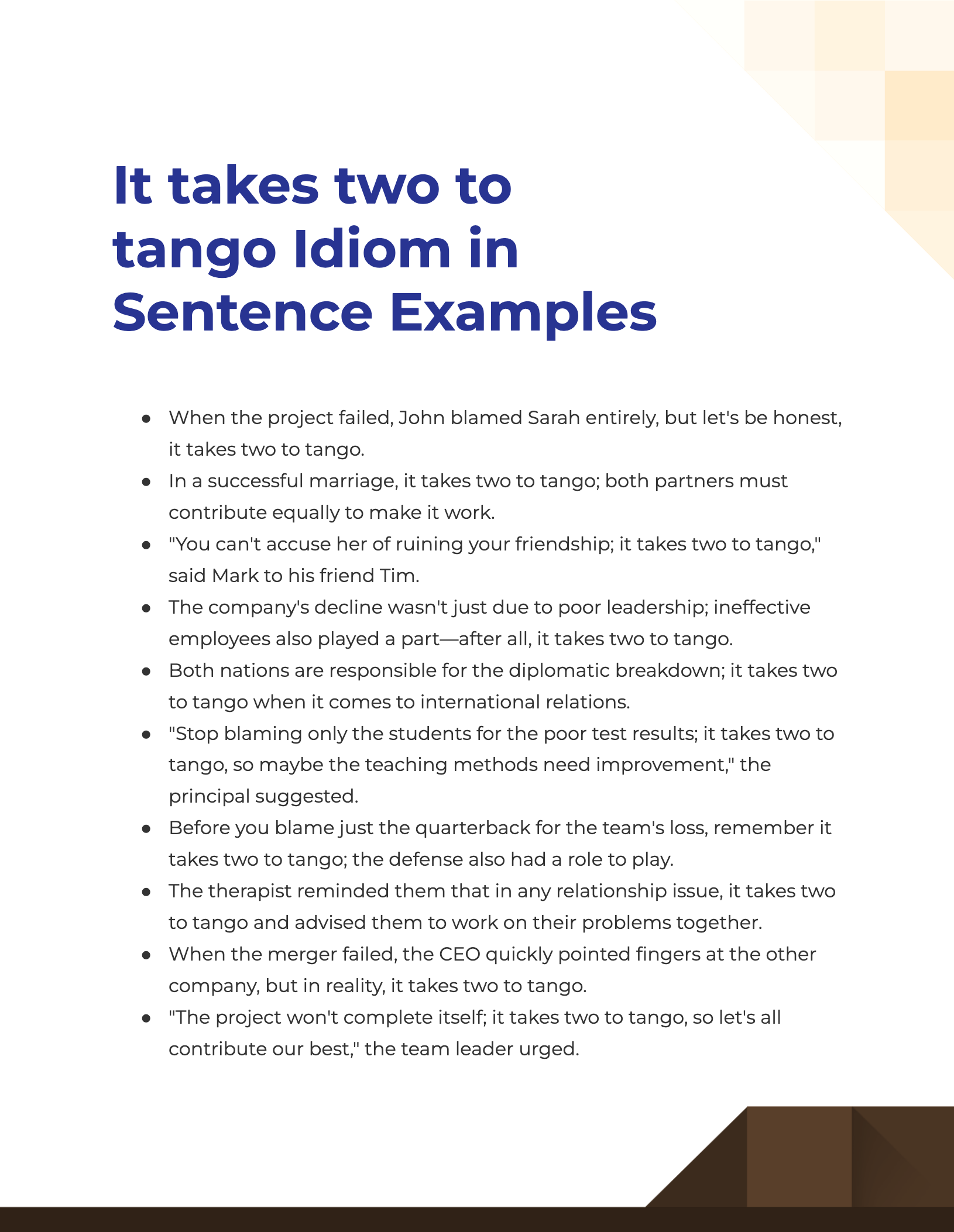19+ It takes two to tango Idiom Examples
Discover the fascinating world of idiomatic expressions with our comprehensive guide on “It takes two to tango.” This idiom is more than just a dance reference; it’s a unique way to express shared responsibility or partnership in various situations. Learn its origin, uncover its nuanced meaning, and explore rich idiom examples to better grasp how you can use this phrase effectively. This guide is a must-read for language enthusiasts, offering invaluable insights and practical tips.
What is the It takes two to tango Idiom? – Definition
The idiom “It takes two to tango” means that certain situations or actions involve more than one person’s participation or fault. In simple terms, it emphasizes that some tasks or responsibilities are shared and cannot be accomplished by an individual alone.
What is the Meaning of It takes two to tango Idiom?
When you use the idiom “It takes two to tango,” you are often highlighting the fact that both parties in a situation share the responsibility or blame for it. For instance, in an argument, the idiom could be used to point out that both people are equally responsible for the disagreement. It suggests a mutual engagement or collaboration in a particular action or circumstance, whether it’s something positive like a project or something negative like a conflict.
Origin of It takes two to tango Idiom
The expression “It takes two to tango” has its roots in the name of the popular Latin American dance, the Tango, which indeed requires two participants. However, the idiom’s widespread usage in the English language became prominent after it was used in a song by Pearl Bailey in the 1950s. Since then, the idiom has evolved to be a metaphorical way to describe any situation where more than one person’s involvement is necessary. It has now become a part of everyday language, highlighting the importance of collective action or shared responsibility.
20 Best Sentence Examples with It takes two to tango Idiom

- When the project failed, John blamed Sarah entirely, but let’s be honest, it takes two to tango.
- In a successful marriage, it takes two to tango; both partners must contribute equally to make it work.
- “You can’t accuse her of ruining your friendship; it takes two to tango,” said Mark to his friend Tim.
- The company’s decline wasn’t just due to poor leadership; ineffective employees also played a part—after all, it takes two to tango.
- Both nations are responsible for the diplomatic breakdown; it takes two to tango when it comes to international relations.
- “Stop blaming only the students for the poor test results; it takes two to tango, so maybe the teaching methods need improvement,” the principal suggested.
- Before you blame just the quarterback for the team’s loss, remember it takes two to tango; the defense also had a role to play.
- The therapist reminded them that in any relationship issue, it takes two to tango and advised them to work on their problems together.
- When the merger failed, the CEO quickly pointed fingers at the other company, but in reality, it takes two to tango.
- “The project won’t complete itself; it takes two to tango, so let’s all contribute our best,” the team leader urged.
- Even if you think the fault lies solely with your co-worker, keep in mind that it takes two to tango when you’re part of a team.
- Environmental preservation isn’t just the government’s responsibility; it takes two to tango, and citizens must do their part as well.
- You can’t blame the musicians for the poor concert performance; it takes two to tango, and the a technicians had their share of errors.
- If you think about it, it takes two to tango in a political debate; both sides need to present strong arguments to make it compelling.
- Don’t just blame your partner for the communication breakdown; it takes two to tango, so consider your own actions as well.
- The coach told the players that to win the championship, it takes two to tango: both offense and defense must be strong.
- “I think both of us are responsible for this mess; after all, it takes two to tango,” Alice said during the heated argument.
- For a business to succeed, it takes two to tango: a great idea and flawless execution.
- It’s easy to blame one parent for the troubled child, but it usually takes two to tango when it comes to parenting.
- During the peace talks, the mediator reminded both parties that it takes two to tango and encouraged them to find a middle ground.
More Famous Idioms with Meaning, Sentence Examples
- Play It by Ear Idiom
- In Black and White Idiom
- Crocodile Tears Idiom
- Full of Beans Idiom
- Busy as a Bee Idiom
- Snake in the Grass Idiom
- Once in a blue moon
- Break a leg Idiom
- Beat around the bush Idiom
- Bite the bullet Idiom
- Through thick and thin Idiom
- Actions speak louder than words Idiom
- Go down in flames Idiom
- Jump on the bandwagon Idiom
- Call it a day Idiom
- A blessing in disguise Idiom
- Come rain or shine Idiom
- On cloud nine Idiom
- Better late than never Idiom
- Hit the sack Idiom
- Go the extra mile Idiom
- The Whole Nine Yards Idiom
- A penny for your thoughts Idiom
- Pull someone’s leg Idiom
- As right as rain Idiom
- Ignorance is bliss Idiom
- Throw caution to the wind Idiom
- Kick the bucket Idiom
- Take a rain check Idiom
How to Use “It Takes Two to Tango” Idiom in Sentences?
The idiom “It takes two to tango” is a versatile phrase that can be applied in many contexts, from interpersonal relationships to corporate dynamics. However, like all idioms, its impact is best when used appropriately and sparingly. Here’s a guide on how to effectively incorporate this idiom into your conversations or writings:
Be Contextually Relevant
Make sure the situation involves shared responsibility or action between two parties. The phrase will lose its effect if it’s used in a context where only one party is clearly responsible.
Maintain Clarity
While idioms add color to language, they can also be confusing for those unfamiliar with them. Make sure your audience can glean the idiom’s meaning from the context in which it’s used.
Use for Emphasis
The idiom works well when you want to emphasize that both parties are equally responsible for a situation or an outcome.
Keep it Conversational
This idiom is generally more suited to casual conversations and informal writing rather than academic or formal settings.
Pair with Evidence
When stating that “it takes two to tango,” support your statement with examples or evidence that demonstrate both parties’ involvement in the situation.
Examples
- In relationship conversations: “You can’t blame just him for the relationship problems; it takes two to tango.”
- In corporate settings: “The failed project wasn’t just due to marketing; the product design was also flawed. It takes two to tango.”
Tips for Using “It Takes Two to Tango” Idiom
Know Your Audience
In international or multilingual settings, be cautious when using idioms as they might not translate well. Make sure your audience is familiar with the phrase.
Limit Repetition
Like any idiom or figure of speech, “It takes two to tango” loses its impact when overused. Limit its repetition in a single conversation or piece of writing.
Complement with Body Language
When speaking, complement the idiom with appropriate body language to emphasize the shared responsibility you’re highlighting.
Balance with Literal Language
To ensure that your message is clear, balance the use of this idiom with literal statements that convey your point straightforwardly.
Review and Revise
When using the idiom in writing, it’s always good to review your work to make sure that its inclusion is necessary and adds value to your text.
By following these guidelines, you can use the idiom “It takes two to tango” effectively, enriching your conversations and writings in a meaningful way.



